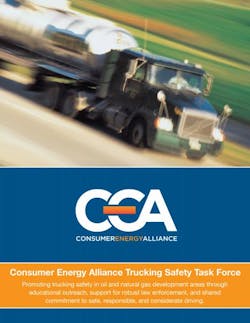Yet this resulting surge in truck traffic is happening in often remote corners of the nation ill-equipped to handle such a huge influx of big rigs – areas usually sporting just “country roads” that make operating tractor-trailers a far trickier task.
But if the U.S. really wants to make a sustained push to be more “self-reliant” on energy – indeed, to potentially become this century’s Saudi Arabia due to plentiful concentrations of oil and natural gas reserves – then those trucks will be sorely needed in terms of delivering all sorts of necessary equipment and goods to support drilling and extraction operations.
To that end, the Consumer Energy Alliance (CEA) decided to help both the energy and transportation industries get ahead of the “safety curve” so to speak by crafting a series of recommendations for not just truckers but producers and even the motoring public as well to help improve road safety and traffic management in those now-heavily travelled regions.
The American Petroleum Institute (API), the American Trucking Associations (ATA) and the National Tank Truck Carriers (NTTC) starting working together with the CEA last year to come up with a series of safety guidelines – guidelines formally adopted by all them this year and now available online.
“What we’re really trying to do is help mitigate roadway safety issues before they become issues in the first place,” Shawn Martini, CEA’s communications director, told me by phone.
“And this is not just about focusing on trucking companies and making sure they follow all the proper safety procedures, because we recognized that safety is a two-way street here,” he stressed. “So there are recommendations in this report for energy producers, too, and even the general public.”
For example, the report encourages energy producers to:
- Minimize truck waiting times
- Provide basic facilities for driver comfort and rest if waiting is necessary
- Require proof of regulatory compliance from transportation providers
- Conduct frequent meetings with transporters to evaluate safety issues and establish process that promote safety
“There’s recognition among many involved with this that transportation could become the ‘Achilles heel’ to the growth of U.S. domestic energy production if we don’t focus more closely on highway safety,” CEA’s Martini stressed to me.
“The biggest take away from this report, however, is that it demonstrates the willingness of energy producers and transporters to work together, with each doing their own part to help improve safety,” he added. “This was a completely voluntary effort – everyone involved is a willing partner.”
But I think John Conley, past president of the NTTC and co-chair for the group that put this report together, really summed up best what such guidelines are ultimately designed to do.
“Trucks are the essential workhorses of our country’s ability to take advantage of our shale gas and oil resources to become energy independent,” he said. “That is why it is the trucking industry’s responsibility to provide safe, efficient, and to the extent possible, considerate truck support of this important energy opportunity.”
And if it’s done safely, with consideration for motorists and other parties along the way, the industry should realize a lot of profit in the process – all while reducing the need to import oil, providing a far more secure energy future for our country. That’s a big plus to all of this, if you ask me.




